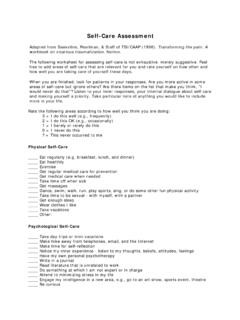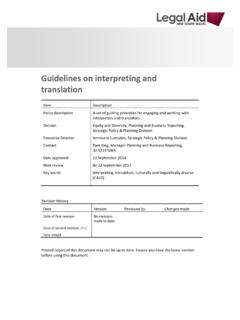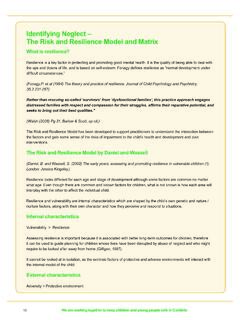Transcription of WHEEL OF EMOTIONS Basic Emotions - Deloitte
1 ECSTA SYJOYSERENITYVIGILANCEANTICIPATIONINTERE STRAGEANGERANNOYANCEBOREDOMDISGUSTLOATHI NGPENSIVENESSSADNESSGRIEFDISTRACTIONSURP RISEAMAZEMENTAPPREHENSIONFEARTERRORADMIR ATIONTRUSTACCEPTANCEMANAGINGWith over 34,000 distinguishable EMOTIONS , psychologist Robert Pluchik has elegantly simplified and organized our instinctive state of mind into eight Basic EMOTIONS in his WHEEL of OF EMOTIONSE motions influence how we live and interact with each other. The choices we make, the actions we take, and the perceptions we have, are all influenced by the EMOTIONS we experience at any given are instinctive and neurological reactions to a stimulus, creating biochemical and electrical reactions activated through neuro-transmitters and hormones released by the brain ( , frightened by the cat jumping on you from behind).Feelings are mental associations and reactions to an emotion that we assign with a particular meaning, influenced by our personal experiences, temperament, beliefs, memories, and thoughts ( , excited that your favorite sports team won the game).
2 EMOTIONS AND FEELINGS ARE OFTEN USED INTERCHANGEABLY, are eight primary EMOTIONS , which are grouped into four pairs of polar opposites: Basic EmotionsAdding EMOTIONS together produces new ones, for example: CombinationsTrust + Fear = SubmissionJoy + Trust = LoveAnticipation + Joy = OptimismJoy - SadnessAnger - FearTrust - DisgustSurprise - AnticipationThe degree of change from mild to strong produces additional EMOTIONS , for example:IntensityAnnoyance > Anger > RageDistraction > Surprise > AmazementSerenity > Joy > EcstasyCONTEMPTREMORSEDISAPPROVALAWEOPTI MISMAGGRESSIVENESSSUBMISSIONLOVEPOSITIVE NEGATIVEHIGHLOW Angry Frustrated Tense Defensive Fearful Anxious Exhausted Burned out Defeated Hopeless Sad Grieving Energized Connected Challenged Hopeful Aligned Passionate Carefree Peaceful Resting Mellow Relaxed Mind-wanderingAmbiguous Response: Avoid them and walk awayNegative Response: Argue and / or belittle themResearch has shown that social connectedness often drives an upward spiral of positive EMOTIONS and can improve physical health, and mental and emotional who feel connected to others: have 50% increased chance of longevity have lower levels of anxiety and depression are more trusting and cooperative have better emotion regulation skills have stronger immunity have higher self-esteem have greater empathyWHAT HAPPENS WHEN YOU ARE EXPERIENCING AN EMOTION?
3 MAPPING YOUR emotional ENERGY THE IMPORTANCE OF MEANINGFUL SOCIAL CONNECTIONSThe EMOTIONS we feel have a subjective, physiological, and expressive component how we experience the emotion and how our body reacts to the emotion can influence the actions we take and the decisions we make to help us survive, avoid danger, form social connections, and YOUR EMOTIONSP ositive and negative energyPositive EMOTIONS like joy, trust, and surprise makes us feel good and are easy to grasp. Negative EMOTIONS are typically unpleasant but just as important. It is an inevitable part of life and something we need to experience to appreciate a full, rich life. Fear can help protect us from harm; and disgust can help us reject what is and low intensityConstantly looking over your shoulder, feeling tensed and anxious, or fearful and frustrated from making mistakes is draining and can eventually lead to feeling hopeless, defeated, and depressed.
4 Conversely, feeling energized, challenged, and passionate allows you to perform at your best but, without proper rest and recovery, can also lead to exhaustion and and long durationThe same primal instinct that enables our fight-or-flight response to avoid being eaten by the saber-toothed tiger can also come in handy when someone cuts us off in traffic. The event triggers heightened awareness and quick reactions; the burst of emotion and annoyance at the driver is short-lived. On the other hand, ruminating over a work disappointment or suffering a loss of a relationship can have an emotional response that is long-lasting and can impact our mental health and emotional : You re juggling multiple dead- lines and did not sleep well the night beforeMemory: You re reminded of a bullyPositive Response: Pause. Take a few breaths and reflect on why you are angry. Proceed with thoughtful words or actions that will support you in the momentTrigger Event: Someone harshly disagreed with youPhysical state: Heart rate goes up, body tensed, jaw clenchedMental state: You feel attacked and/or feel disappointmentEmotional State: Anger SOURCE: Adapted from Atlas of EMOTIONS by Dr Paul Akman and his daughter Eve Ekman.
5 ZoneBurnout ZonePerformance ZoneRecovery ZoneSource: ATHEPHYSICALACTIVITYSELFCOMPASSIONNEGATI VE BIASCHALLENGEE motional intelligence or EQ is the ability to recognize and understand that EMOTIONS can drive behaviors with positive or negative impact to self and others. Learning how to manage those EMOTIONS for yourself will also give you the insight to help influence the EMOTIONS of others to create better human YOUR emotional INTELLIGENCEEMOTIONAL intelligence MATRIXTIPS TO HELP YOU MANAGE YOUR EMOTIONSWhen strong EMOTIONS arise, a few deep breaths can often help you feel calmer. Yes, it s that simple. Mindfulness meditation practice can help you pay attention to your body and alert you when your EMOTIONS are taking and other forms of active movement release the feel-good chemicals in the brain. Group classes like yoga, Pilates, indoor cycling, or organized hikes and walking tours can further enhance social kind to others and share your appreciation.
6 Kindness is a behavioral response of empathy and compassion with actions that are selfless and can lead to a sense of interconnectedness with others. When you focus on others, you stop worrying about yourself. Learn to let go and be open and accepting of what is going on around you. Don t forget to be gentle with yourself and avoid excessive self- criticism. Journaling and reflection will help you appreciate the goodness that surrounds t bottle it up. Spend time with friends and family. Establish a strong support system. Be authentic and share what s going on the good, the bad, the ugly. Don t just vent. Be a good listener too. Invite others to share and learn from their perspectives. When you have negative thoughts, reflect on the underlying cause and try to redefine and reframe them with a positive attitude before you make mountains out of COMPETENCEMy ability to maintain awareness of my EMOTIONS and manage my behaviorsRECOGNITIONWhat I SEE (Mindfulness)REGULATIONWhat I DO (Empowerment)SOCIAL COMPETENCEMy ability to understand others to improve relationshipsSELF AWARENESSHow am I accurately perceiving and understanding my EMOTIONS ?
7 Feelings and emotional impact to self and others Values that drive your EMOTIONS Objectivity Triggers Preferences/Tendencies Strengths/Limitations Ability/CapabilitiesSOCIAL AWARENESSDo I accurately perceive and understand the EMOTIONS and behaviors of others? Empathy Organizational culture Service orientation assessing the mood in the room Picking up verbal and non-verbal cues Sensitivity to others feelings Shifting perspectiveRELATIONSHIP MANAGEMENTDo I work well with others and impact others effectively? Communication/Interpersonal effectiveness Influence/Change catalyst Teamwork/Collaboration/Comradery Inspirational leadership Conflict management Developing others/Coaching/Mentoring Building trust/Bonds/Rapport Finding common ground Amplify positive emotionsSELF MANAGEMENTHow am I managing my EMOTIONS and behavior productively? Impulse/Self control Adaptability/Resilience Motivation/Drive Transparency Optimism/Positive outlook Conscientiousness/Integrity Take Initiative Intentionality/Choosing how to act/ReactCopyright 2020 Deloitte Development LLC.
8 All rights Well-being is Deloitte s holistic approach that gives our people the support and flexibility to make daily choices that can enable them to be energized, confident, and aware. It provides the opportunity for our people to personalize their experiences in the ways that matter most to them in body, mind, and purpose. About Empowered Well-beingDeloitte refers to one or more of Deloitte Touche Tohmatsu Limited, a UK private company limited by guarantee ( DTTL ), its network of member firms, and their related entities. DTTL and each of its member firms are legally separate and independent entities. DTTL (also referred to as Deloitte Global ) does not provide services to clients. In the United States, Deloitte refers to one or more of the US member firms of DTTL, their related entities that operate using the Deloitte name in the United States and their respective affiliates. Certain services may not be available to attest clients under the rules and regulations of public accounting.
9 Please see to learn more about our global network of member DeloitteThe activities referenced here are in no way sponsored or endorsed by Deloitte and participation in any such activities is wholly voluntary and at your own risk. All information presented here is intended for your general knowledge only and is not a substitute for professional medical advice or treatment for specific medical conditions. You should seek prompt medical care for any specific health issues and consult your physician before starting a new fitness an event triggers an emotion, there is a space between the stimulus and response to pause before reacting. This allows you to see and choose your thoughts, then shift your response with more considered words and actions to determine a desired positive AGILITYTo avoid operating on autopilot and resorting to default behaviors, psychologist Dr. Susan David outlines four key concepts to get unstuck, embrace change, and thrive in work and life:Showing Up: EMOTIONS are, by their very nature, strong, instinctive states of mind and often difficult to ignore.
10 Practicing mindfulness will help you focus your attention on the present moment and to recognize your emotional patterns without judgement. Be open to face your thoughts, EMOTIONS , and behaviors with courage, curiosity, and compassion. Acknowledge that denying or ignoring negative thoughts aren t helpful and it s better to learn from them to disrupt the pattern and initiate meaningful Out:We typically fall into thinking traps that cloud our minds unnecessarily and incessantly. When you can step back to create distance, observe and disentangle thoughts from feelings, label them objectively, and start to see the big picture with informed clarity that you are not your emotion then you can use emotional intelligence from I m angry! to I notice that I m experiencing anger. Identify possible causes of the emotional event based on facts not On:Leave the negativity behind. emotional agility is not a natural or inherent quality.
















